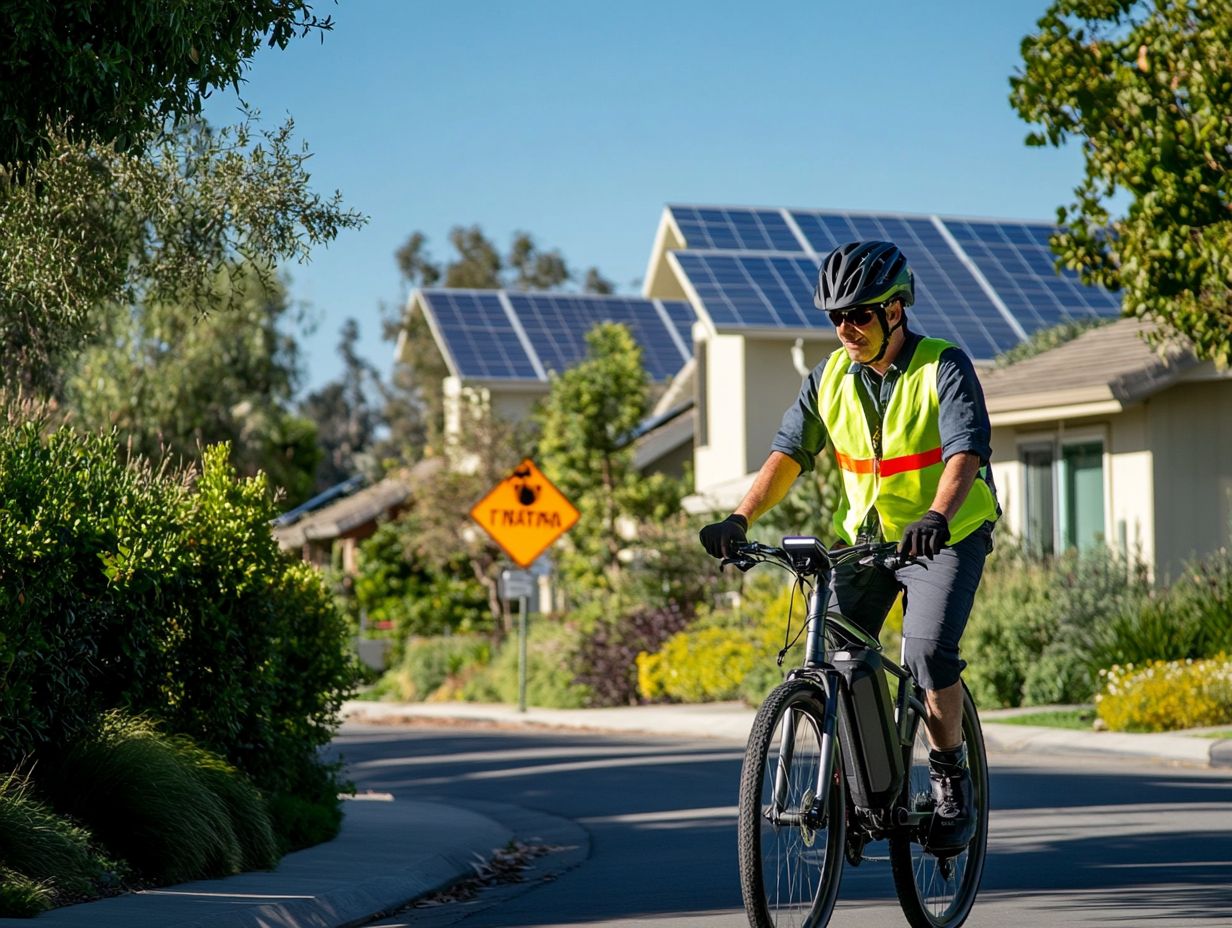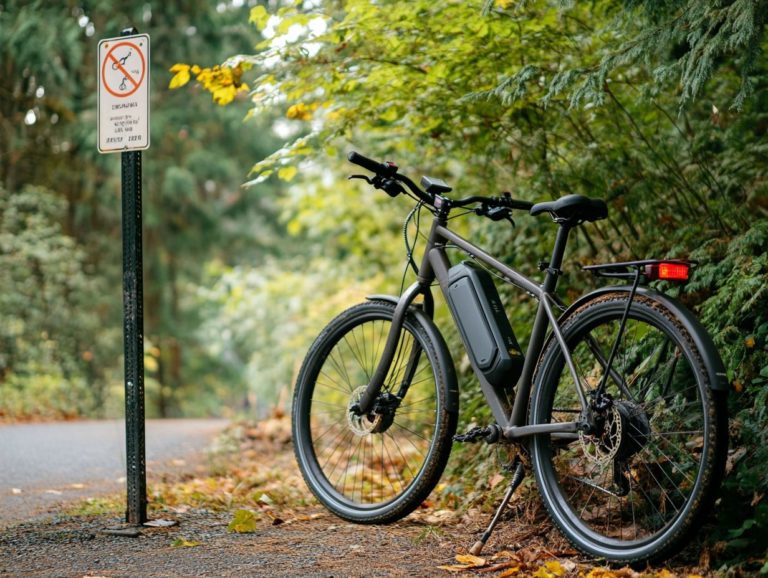Electric Bicycle Regulations in the Era of Climate Change
As cities confront urgent challenges from climate change, electric bicycles (E-bikes) are stepping into the spotlight as a sustainable transportation solution. They are set to redefine urban mobility.
Navigating e-bike regulations can be complex. This article explores how climate change affects transportation and how regulations can enhance safety and fairness for all road users.
Join us as we explore the exciting future of electric bicycle regulations that could change your community for the better!
Contents
- Key Takeaways:
- The Impact of Climate Change on Transportation
- Current Regulations on Electric Bicycles
- Benefits of Regulating Electric Bicycles
- Challenges in Implementing Regulations
- Future of Electric Bicycle Regulations
- Frequently Asked Questions
- What are electric bicycle regulations in the era of climate change?
- Are electric bicycles subject to the same regulations as traditional bicycles?
- What are some common regulations for electric bicycles in the era of climate change?
- Do electric bicycles require a license or registration?
- Are there any financial incentives for using electric bicycles in the era of climate change?
- What can individuals do to advocate for better electric bicycle regulations in the era of climate change?
Key Takeaways:

- Electric bicycles offer a sustainable solution to a major contributor to climate change.
- Regulations are necessary to ensure safety and fairness for everyone.
- The future of e-bike regulations holds great potential for promoting sustainable transportation.
What are Electric Bicycles?
Electric bicycles, often called E-bikes or pedal-assisted bicycles, blend traditional cycling with modern electric power. They use batteries that power many electronic devices to help you pedal, making urban navigation easier.
With rising interest in sustainable transportation, E-bike usage has soared. Initiatives like the E-BIKE Act encourage electric mobility and provide incentives for e-bike sales across the country.
These bicycles are equipped with various advanced components, including motors and control systems, designed to enhance your riding experience. The increase in E-bike sales signals a shift toward eco-friendly options, especially in delivery services where electric cargo bikes excel.
E-bikes reduce carbon footprints and lead to significant cost savings over time.
The batteries are essential for longer ranges and faster charging, meeting the growing demands of urban logistics and paving the way for a sustainable future.
The Impact of Climate Change on Transportation
Climate change is an urgent challenge that deeply affects transportation systems worldwide. It increases emissions and carbon outputs, worsening urban air quality and public health.
This highlights the critical need for sustainable transportation solutions like electric bicycles that can help address these issues.
Why Electric Bicycles are a Sustainable Solution
E-bikes offer a powerful solution to urban transportation challenges. They reduce reliance on short car trips, lowering carbon emissions and promoting eco-friendly alternatives.
Using E-bikes can save you time and contribute to cleaner air. They also relieve pressure on public transport systems and stimulate local economies by encouraging sustainable commuting.
By promoting the installation of electric bicycle infrastructure, cities support healthier lifestyles and allow commuters to enjoy more physical activity.
This shift not only reduces pollution but also fosters a community dedicated to well-being and sustainability.
Current Regulations on Electric Bicycles

Current regulations on electric bicycles differ significantly from one region to another. They are shaped by federal agencies dedicated to ensuring safety and advancing electric mobility. These regulations cover essential aspects like e-bike injuries, helmet requirements, and emissions standards, all working towards a balanced framework.
This framework aims to promote the adoption of electric bicycles while placing a strong emphasis on community safety.
Overview of Local and National Laws
Local and national laws surrounding electric bicycles are vital for promoting their usage and ensuring public safety. These regulations vary, reflecting the unique needs of different communities. Groups that support biking play a pivotal role in shaping these laws and backing infrastructure projects that enhance bike networks and safety.
These regulations define what qualifies as an electric bicycle, establish speed limits, and specify where these bikes can be ridden. Often, distinctions are made between classes of electric bikes based on their maximum speed and whether they assist the rider’s pedaling, as outlined in the electric bicycle regulations in urban areas.
Advocating for cycling infrastructure such as dedicated bike lanes and secure bike parking ensures that policies are effective and considerate of community needs. As cities and towns navigate these complex laws, it s essential for you, as both a rider and a policymaker, to become educated about local requirements. This knowledge is crucial for fostering a safer and more inclusive riding environment.
Benefits of Regulating Electric Bicycles
Regulating electric bicycles brings countless benefits that can transform our communities! From enhanced traffic safety to improved community well-being, the advantages are significant.
By establishing clear regulations, you can effectively reduce e-bike-related injuries and foster safe environments for electric bicycle users. For detailed information on how to navigate electric bicycle licensing requirements, this not only encourages the adoption of eco-friendly transportation alternatives but also contributes to a more sustainable future for all.
Ensuring Safety and Fairness
Ensuring safety and fairness within electric bicycle regulations is essential for fostering an inclusive transportation environment. We must prioritize community safety and minimize traffic accidents. By establishing clear guidelines and standards, you can help create frameworks that promote responsible electric bicycle usage while safeguarding all road users.
Such regulations not only protect riders but also pedestrians and motorists, ensuring that everyone can share the road safely. For more detailed information, refer to the electric bicycle path regulations: a complete guide. Striking a balance between innovation and public safety is crucial. Developing a robust set of rules can effectively mitigate the risks associated with electric bicycles.
You can enhance responsible usage by supporting educational campaigns that inform electric bicycle users about safe riding practices, the importance of adhering to speed limits, and recommending designated paths to reduce potential conflicts with other forms of transportation.
Ultimately, clear regulations can foster greater public trust and acceptance of electric bicycles as a sustainable commuting option.
Challenges in Implementing Regulations

Implementing regulations for electric bicycles presents a range of challenges, including facing opposition from various stakeholders. There is a critical need to gather appropriate community input to address concerns effectively.
Striking a balance between these challenges and the imperative of investing in infrastructure and ensuring public safety can be complex. It requires thoughtful collaboration among diverse entities to navigate this intricate landscape.
Stay updated on local regulations to ensure you’re riding safely and responsibly.
Addressing Concerns and Opposition
Addressing concerns and opposition surrounding electric bicycle regulations is essential for fostering community engagement and promoting a deeper understanding of safety measures.
By involving stakeholders in the decision-making process, you can help create policies that reflect the diverse needs of your community while ensuring the effectiveness of safety regulations.
To achieve this, it’s crucial to establish open lines of communication. Utilize forums, surveys, and public meetings to gather input and share valuable information.
Encouraging dialogue allows community members to voice their concerns and suggestions while also educating them about the benefits and safety features of electric bicycles.
Forming partnerships with local businesses, advocacy groups, and transportation experts can further strengthen the rules by incorporating varied perspectives.
When stakeholders feel heard and valued, cooperation increases, ultimately leading to regulations that better serve everyone and foster a safer environment for all road users.
Future of Electric Bicycle Regulations
The future of electric bicycle regulations is brimming with potential, offering opportunities for enhancements that can elevate safety, foster sustainable transportation, and bolster infrastructure projects tailored for electric mobility.
By adapting current regulations to align with new technologies that help electric bicycles function better and the needs of the public, you can help ensure that electric bicycle usage becomes integral to future transportation systems.
Potential Changes and Improvements
Potential changes and improvements in electric bicycle regulations could greatly elevate safety standards and encourage robust community involvement in the regulatory landscape.
By actively engaging stakeholders and embracing best practices, you can help shape regulations that not only promote electric bicycle usage but also prioritize public health and safety.
Implementing minimum safety requirements like mandatory helmet use and enhanced visibility measures can significantly reduce accidents involving electric bicycles.
Encouraging local governments to establish community forums will give both riders and non-riders a platform to voice their concerns and suggestions, fostering a more inclusive approach to regulation.
Adopting best practices from regions with successful electric bicycle programs provides a valuable blueprint for standardizing regulations across the country.
Investing in education and outreach programs aimed at both cyclists and motorists can improve road-sharing strategies, ultimately cultivating a safer and more harmonious environment for all road users.
Frequently Asked Questions

What are electric bicycle regulations in the era of climate change?
Electric bicycle regulations in the era of climate change refer to laws and guidelines to regulate the use of electric bicycles to reduce carbon emissions and combat climate change.
Are electric bicycles subject to the same regulations as traditional bicycles?
It depends on the specific regulations in your area. In some places, electric bicycles are categorized as motorized vehicles and are subject to different regulations than traditional bicycles.
It is important to check with your local government to understand the specific regulations for electric bicycles in your area.
What are some common regulations for electric bicycles in the era of climate change?
Some common regulations include speed limits, age restrictions, and guidelines for where electric bicycles can be ridden.
These regulations ensure the safety of riders and pedestrians while promoting sustainable transportation options.
Do electric bicycles require a license or registration?
This depends on the regulations in your area. Some places may require a license and registration for electric bicycles, while others may not.
It is important to research and understand the regulations in your specific location.
Are there any financial incentives for using electric bicycles in the era of climate change?
Yes, many cities and countries offer financial incentives to encourage the use of electric bicycles. These can include tax breaks, financial support that helps reduce costs, or discounts on purchases, all aimed at promoting eco-friendly transportation.
What can individuals do to advocate for better electric bicycle regulations in the era of climate change?
Individuals can contact local government officials to show their support for electric bicycles. They can also join community events that highlight how electric bikes can help combat climate change.




